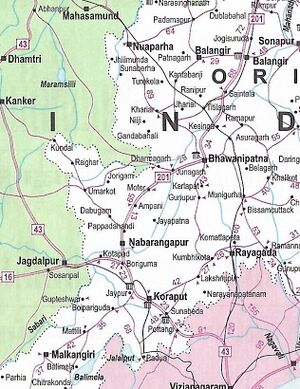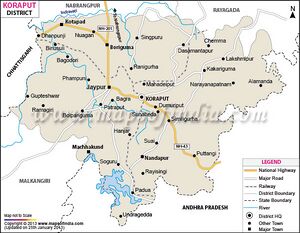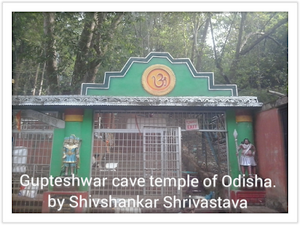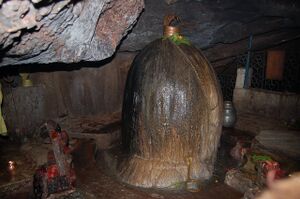Gupteshwar cave
| Author: Laxman Burdak IFS (R) |




Gupteswar Cave is a cave shrine dedicated to Shiva.[1] Gupteshwar cave is located in Koraput district of Odisha near the border of Bastar district in Chhattisgarh. Author (Laxman Burdak) visited Gupteshvara Cave on 17.03.1983
Variants
Location
Gupteshwar cave is a pilgrim site situated about 55 km away Jeypore, Koraput District in the state of Odisha, India. It is a limestone cave, and its main attraction is the gigantic Shiva Linga which is said to be increasing in size. It is believed that the cave was discovered by Rama and re-discovered in the reign of Maharajah Veer Vikram Dev. In the holy month of Shravan, the cave is visited by devotees who walk to the shrine bare-footed with decorated bamboo palanquins called "Kanwadiya" and bathe in the maha kund before worshipping Lord Gupteshwar. There are 200 steps to reach to the Shiva linga temple. Its entrance is about 3 metres wide and 2 metres high.[2]
History
Author (Laxman Burdak) visited Gupteshvara Cave on 17.03.1983 and has mentioned in his diary:
17.03.1983: Jagdalpur - Tiriya Forest and back 7.30 – 17.30 hrs 100 km govt veh. Visited compartment-49 of Machkot Range. Marking was got done in this area by by A.A. Boaz IFS. Visited Gupteshvara Cave.
Legend
Surrounded by a dense forest of sal trees and flanked by the Kolab river, a 2 metres high lingam stands in the cave. The shrine is called "Gupteswar" which means the "God in hiding" because the lingam remained undiscoverable for a long time. One can reach it by climbing the 200 steps flanked with rows of champak trees. There are also several other caves nearby. Inside the second cave, there is a large stalactite. People worship it as the udder of God Kamadhenu (the divine cow) and wait under it with outstretched palms to collect drops of water which fall only at long intervals.
Popularly known as "Gupta Kedar" in the vicinity, this sacred place is associated with the Hindu god, Lord Shri Rama. The nearby hill has been named "Ramagiri". According to tradition, the lingam was first discovered by Lord Rama when he was roaming in the Dandakaranya forest with wife Sita and brother Lakshman, and named the deity in the cave as "Gupteshwar". The poet Kalidas too, described the scenic beauty of Ramagiri forest where the cave temple is referred to in his famous Meghadutam.
However, as the time passed, the temple was again lost in obscurity but in the 17th century, the Shiva lingam was discovered by a hunter who then informed about it to Maharajah Veer Vikram Dev, who was the king of that region and recently shifted his capital from Nandapur to the newly formed, Jeypore. King Veer Vikram paid a visit to the cave and was mesmerized by the grandiosity of the majestic lingam and the magnificent natural surroundings. He appointed priests in the cave temple and started a tradition of making a foot journey to the cave of Lord Gupteswar during the holy month of Shraavana which is performed by the people of the erstwhile kingdom to this day. Since then the lingam has been worshipped by the tribes and locals of Koraput region. In Shivaratri (a Hindu festival) Gupteswar Temple draws over 200,000 devotees from Odisha, Andhra Pradesh and Chhattisgarh. People suffering from incurable diseases come here to worship the god and remain here for months in the hope of getting cured.
गुप्तेश्वर धाम
भगवान शिव का यह प्रसिद्ध गुफा मंदिर चूना पत्थर की एक पहाड़ी पर स्थित है। कोलाब नदी के किनारे यह पहाड़ी प्राकृतिक दृश्यावली से भरपूर है। मंदिर के पवित्र लिंगम् को गुप्तेश्वर कहा जाता है जिसका अर्थ छिपे हुए भगवान होता है। छत्तीसगढ़ में इसे गुप्त केदार के नाम से जाना जाता है। शिवरात्रि के मौके पर यहां बड़ी संख्या में शिवभक्तों का आगमन होता है। उड़ीसा सीमा रेखा के कोलाब नदी के किनारे यहा शिव मंदिर स्थित है। राष्ट्रीय उद्यान के माचकोट रेंज से यह सीमा लगी हुई है। छत्तीसगढ एवं उडीसा से बडी संख्या में पर्यटक, श्रद्वालु शिवरात्रि के अवसर पर इस मंदिर का दर्शन करने हेतु जाते हैं। वन विभाग के द्वारा कोलाब नदी के उपर लकडी एवं बांस का पुल का निर्माण शिवरात्रि के समय किया जाता है जिससे कि पर्यटक इस मंदिर तक पहुंच सके। मंदिर के अंदर गुफा है जिसमें स्टेलेग्माइट एवं ड्रिप स्टोन की आकर्षक संरचनायें हैं । [3]

